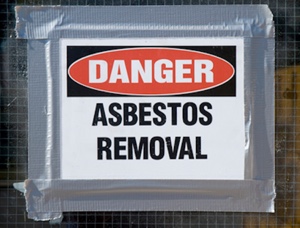 You say you have good business insurance, and that you've taken the time to obtain the right workers compensation insurance protection for your employees and your business. Good for you!
You say you have good business insurance, and that you've taken the time to obtain the right workers compensation insurance protection for your employees and your business. Good for you!
But, have you taken all the proper precautions to protect your construction workers or other employees from asbestos exposure? Doing so is the right thing to do for their protection, and over time it could also lower your workers compensation insurance costs.
What is Asbestos?
Asbestos is a naturally occurring mineral-based material that is widely used in many building products because it is resistant to heat and corrosive chemicals and does not conduct electricity. Asbestos fibers are very fine and can remain suspended in the air for hours. Asbestos comes in all shapes, sizes, and colors, and it’s extremely difficult to see.
Asbestos that is in good condition and undisturbed is safe, but scientists have confirmed that when asbestos materials start to rot or are disturbed by cutting, scraping, drilling, or sanding, toxic fibers are released into the air. Once breathed in, these tiny fibers (1,200 times thinner than a human hair) can get trapped in the lungs and remain there for a long time. As these fibers accumulate, they cause scarring and inflammation, which can affect breathing and cause significant health problems.
Asbestos has been classified as a carcinogen (cancer-causing substance). Continued exposure to asbestos can cause mesothelioma (a cancer that affects the membranes lining the lungs and abdomen), asbestosis (scarring of the lungs, which causes a loss of lung function that often progresses to disability and death), lung cancer, pleural plaques, and cancers of the esophagus, stomach, colon, and rectum.
Often, the symptoms don’t appear until many years after the first exposure (20-50 years is the average gap). Even short-term exposure to a significant amount of asbestos can lead to breathing problems, coughing, and shortness of breath. And, there is evidence that family members of workers heavily exposed to asbestos face an increased risk of developing mesothelioma, as a result of exposure to asbestos fibers brought into the home on the shoes, clothing, skin, and hair of workers. According to the World Health Organization, 43,000 people die annually from asbestos (10,000 Americans).
Banned in 55 Counties
Asbestos has been banned in 55 countries. Its use is restricted in the U.S. (asbestos must account for less than 1 percent of the product.), but it has not been banned. Two million metric tons of the substance are produced every year worldwide. Many U.S. companies have phased out most products that contain asbestos; however, asbestos building materials still exist at many jobsites – especially homes and commercial buildings built before the 1970’s. In 1989, the U.S. Environmental Protection Agency (EPA) banned all new uses of asbestos; however, uses developed before 1989 are still allowed.
Why Construction Workers are at Risk:
Everyone is exposed to asbestos at some time during their life. Low levels of asbestos are present in the air, water, and soil. However, most people don’t become ill from their exposure. People who become ill from asbestos are usually those who are exposed to it on a regular basis.
Throughout the twentieth century, asbestos was incorporated into thousands of construction products, including fire retardant coatings, concrete and cement, bricks, pipes, gaskets, insulations, drywall, flooring, roofing, joint compound, paints, and sealants. Asbestos is a serious risk for construction workers of any trade. Demolition workers who unsafely dispose of asbestos experience some of the highest risks. Roofers, electricians, drywall workers, painters, plumbers, and laborers all face regular exposures, but anyone working on an older structure should be cautious of asbestos.
According the National Institute for Occupational Safety and Health, nearly one-quarter of worker deaths caused by asbestosis between the years 1990-1999 were in the construction trades, by far the most dangerous industry in terms of asbestos exposure.
If your employees perform any of the following tasks, they are at risk of breathing asbestos fibers:
- Cut, drill, sand, or otherwise disturb textured wall/ceiling material or drywall that contains asbestos
- Collect asbestos samples for laboratory analysis
- Remove or repair pipe insulation that contains asbestos
- Strip electrical wiring that contains asbestos insulation
- Remove ceiling tiles that contain asbestos
- Drag cable or wiring through asbestos-containing vermiculite insulation or ceiling tiles, or through asbestos-cement conduit
- Remove vinyl floor tiles or linoleum that contains asbestos
- Demolish concrete block that contains asbestos-containing vermiculite insulation
- Remove asbestos-containing asphalt roofing materials
How Can You Protect Your Employees from Asbestos?
- Read and understand the U.S. Occupational Safety and Health Administration (OSHA) regulations covering asbestos exposure in general industry and construction www.osha.gov/SLTC/asbestos
- Train employees who will be working with and around asbestos, including
- How to recognize asbestos-containing materials http://www.hse.gov.uk/asbestos/gallery.htm
- Awareness of the health hazards of asbestos
- Proper use of personal protective equipment
- Proper handling, removal, and disposal of asbestos
- Develop and implement an exposure control plan for asbestos work
- Have qualified people conduct risk assessments for any asbestos-containing materials that might be disturbed
- Ventilate workspaces
- Monitor employees for asbestos exposure levels
- Keep warning signs and instructions in areas where asbestos-related work is performed
- Require protective clothing, such as overall, gloves, foot coverings, face shields, and goggles.
- Use protective equipment , such as respirators
- Supply shower facilities and other post-exposure precautions
- Require medical examinations for workers who are exposed to high levels of asbestos
Having the Right Health Insurance and Worker's Comp Insurance Pays Off
If one of your employees still becomes ill from exposure to asbestos while working for you, the right insurance – both liability, health, and workers’ compensation insurance – will help ensure the best care with the least financial impact.
We're Here to Help
To determine your business insurance needs, contact American Insuring Group at (800)947-1270 or (610)775-3848. We're independent insurance agents who offer insurance from over 25 competing brands. We’ll make sure you have the right coverage for your business at the right price. Contact us today.







